The Parthenon was constructed around 450 B.C. as a temple to the Goddess Athena (Photograph 1). More recently a temple overlooking Vancouver was constructed by the contractor Gauvin the Younger to honor the God of Building Science Hutcheon (Photograph 2). For the past five years the Devout1 have been sprinkling water on the temple Icons carefully watching the results. Water was added to the Icons2 from the inside and then from the outside and then injected directly. Lo and behold, where the water was added mattered. The amount of water added mattered. And the type of Icon mattered. Who knew? Many of the legends and stories from the Prophets3 were proven true. More importantly new legends and stories were created. The Scribes4 are fast at work as we speak preparing manuscripts of the results that will be presented to the Deacons of Peer Review5 for inclusion after due deliberation into the Fundamentals6. The process is slow and must be followed so as not to anger the Faithful.7 But some of the Devout are anxious. Some of the Devout feel that some of the new legends and stories need to be told before the Deacons of Peer Review have completed their task because of their importance to those who design and construct other temples. In the interim, Faithful from all over the world are making pilgrimages to the temple (Photograph 3) as it is on the tour of temples that have been sprinkled with water either intentionally or unintentionally such as the Denver Art Museum and the MIT Stata Center.
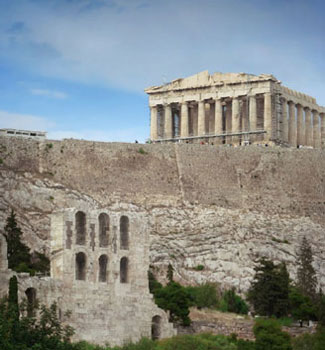
Photograph 1: Parthenon - Constructed around 450 B.C. as a temple to the Goddess Athena (Fotofolia.com © Dino Hrustanovic)
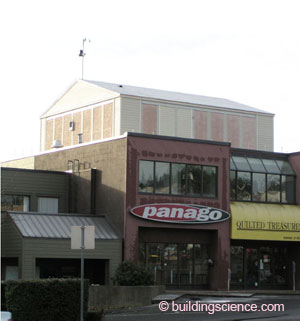
Photograph 2: Temple to Hutcheon – Constructed around 2005 overlooking Vancouver by the contractor Gauvin the Younger to honor the God of Building Science.
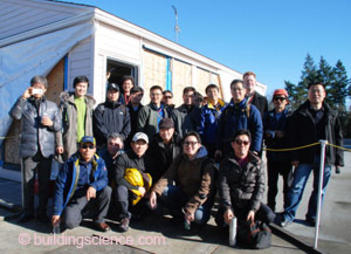
Photograph 3: Building Science Pilgrims – Faithful from Korea viewing wetted icons.
Twenty-eight test panels (4 ft. by 8 ft./1m by 2m) run through 12-month cycles over 6 years? Thousands of data points (Photograph 4 and Photograph 5)–argh! Only crazy people do this kind of stuff. Guess what? Taking the darn things apart every year turned out to be the most insightful. Nothing beats looking at everything–every layer, every side of every layer. You get the idea. It’s the only way to keep the data honest. Are you really measuring what you think you are measuring? The instrumentation was impressive (Figure 1). The entire approach is worth a discussion–but for some other time.
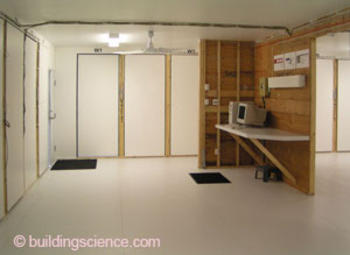
Photograph 4: Interior of Test Hut – Interior east wall elevations
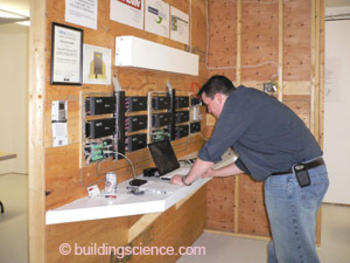
Photograph 5: Data Acquisition – Confused “Scribe” making sense of thousands of sensors.
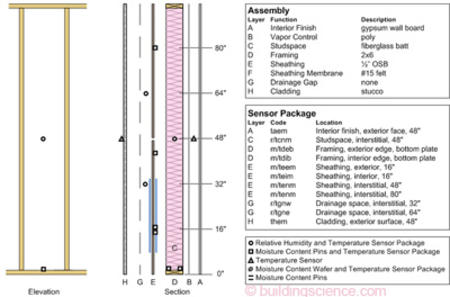
Figure 1: Test Panel Instrumentation – Note the location, number and type of sensors for each of the 28 test panels.
We looked at lots of things. Most of the stuff turned out to be obvious but needed to be documented, measured, demonstrated, whatever. Most of this stuff will ultimately end up in peer-reviewed journal papers that no one will read but lots of folks will reference. But some of the stuff turned out to be interesting stuff. That is what we are going to take a run at now.
So what happens when you install impermeable foam sheathing over oriented strand board (OSB) and the OSB gets wet due to a leak? Can it dry in? Can it dry out? Does it drain? How much drains? Should this type of wall be banned8? Interesting stuff. We already had much of this discussion in BSI-038: Mind the Gap, Eh? But, we now know more, and can actually say more.
Yes, drainage happens between the foam sheathing and the OSB and the wall can dry inward when there is no interior vapor barrier. In fact, such walls perform better than walls with only OSB sheathing and a vapor barrier.
We specifically looked at stucco walls where stucco was applied over building paper over OSB (Photograph 6) and where stucco was applied over impermeable foam sheathing over OSB (Photograph 7). The stucco was traditional “hard-coat” stucco. The walls were 2x6 (0.038m x 0.14m) wood frame insulated with fiberglass batt insulation. The foam sheathing was 1.5 inches extruded polystyrene (R-7.5). The foam sheathing over OSB wall did not have a plastic vapor barrier installed on the interior. The interior vapor control layer for this wall assembly was latex paint (a Class II vapor retarder). The stucco directly over OSB wall had a plastic vapor barrier installed on the interior–a 6-mil polyethylene sheet (a Class I vapor retarder).
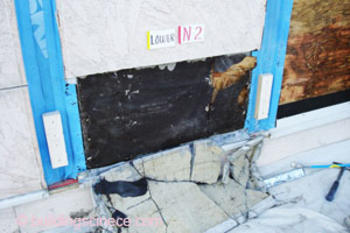
Photograph 6: Stucco over OSB Wall - North elevation deconstruction of hard-coat stucco applied over building paper over OSB.
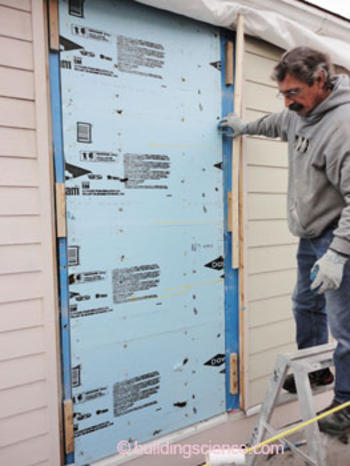
Photograph 7: Stucco over XPS Wall – North elevation deconstruction
Both of these assemblies are “code-compliant” in the United States. However, in Vancouver, the stucco over OSB wall must have an air gap of at least 3/8-inch (10 mm) between the stucco and the OSB sheathing to be code compliant. The air gap turns out to be a very good idea for the stucco over OSB wall. We already knew this and shared this earlier in Mind the Gap, Eh?, as I mentioned above. The folks in Vancouver have known this for a very long time.
The walls were wetted both internally (Photograph 8) and externally (Photograph 9). The external wetting was done behind the “water control layer” – directly into the OSB sheathing to be representative of a flaw or a true leak or construction error or defect. The internal wetting was done in a similar fashion. Water was injected directly against the cavity side of the exterior sheathing–again to be representative of a flaw or construction error or defect.
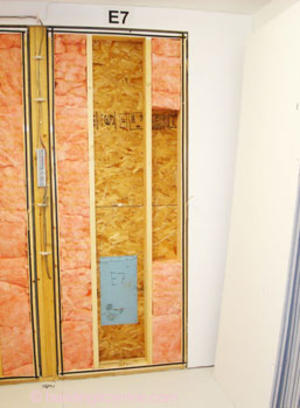
Photograph 8: Interior Wetting Apparatus – Note blue capillary active mat used to distribute water injected into assembly over interior surface of exterior OSB sheathing.
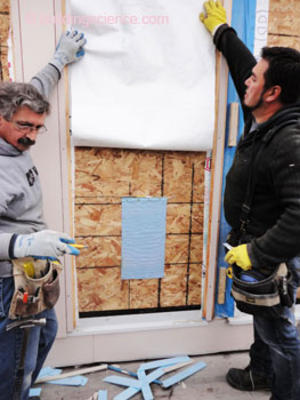
Photograph 9: Exterior Wetting Apparatus – Note that the capillary active mat used to distribute water injected behind cladding is located behind the water control layer directly over the exterior surface of the OSB sheathing.
Wetting events were a week in length and consisted of adding approximately 2 oz. in the morning and 2 oz. in the evening each day. This was our best estimate of a persistent leak resulting in wetting in a concentrated area9. Four external and one internal wetting events were done. Why more from the outside? Easy, it was Vancouver. Duh!
The results are presented in Figure 2 for the north elevation and Figure 3 for the south elevation. Drying turns out to be faster on both the east and west elevations than the north elevation and fastest on the south elevation. No surprise. The OSB moisture contents for “Wall 7”–the stucco over foam over OSB wall–is lower than “Wall 2”–the stucco directly over OSB wall – are lower for nearly the entire year on all elevations. This makes sense if you consider that the wall with foam sheathing is warmer due to the thermal resistance of the foam sheathing and has no interior vapor barrier10.
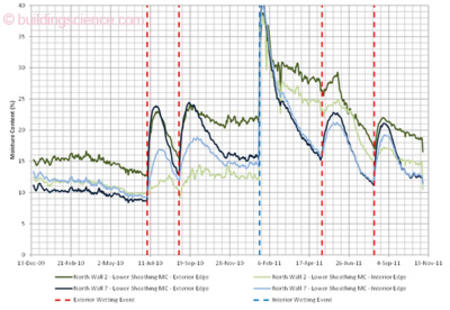
Figure 2: North Elevation OSB Sheathing Moisture Content – Note the wetting events and the drying rates.
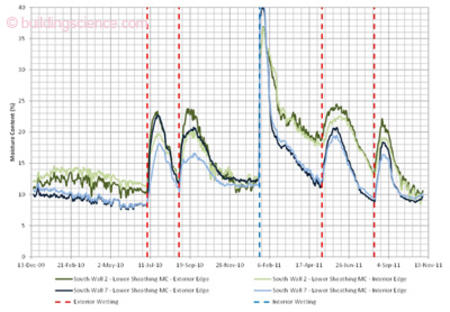
Figure 3: South Elevation OSB Sheathing Moisture Content – Note the wetting events and the drying rates.
We also looked at claddings with and without air gaps behind them. The wall we talked about above with stucco directly applied over the OSB works much, much better with a small gap (3/8-inch or 10 mm) between the stucco and the OSB. Again, this should be no surprise, for stucco. But it turned out to be as important for other cladding systems such as fiber cement siding installed over OSB (Photograph 10). If you install a polyethylene vapor barrier on the inside of your wall and you sheath it with OSB you had better back ventilate your external cladding. It makes a big difference.
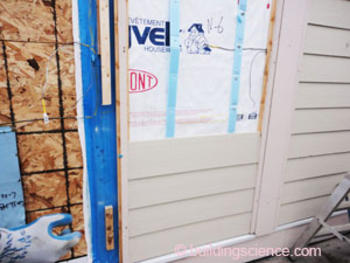
Photograph 10: Fiber cement siding - If you install a polyethylene vapor barrier on the inside of your wall and you sheath it with OSB you had better back ventilate your external cladding. It makes a big difference. Note the “blue” spacer strips that create a 3/8-inch ventilation and drainage gap between the siding and the water control layer.
It is pretty clear that it is ok to install foam sheathing over OSB. We have been doing it for about 40 years without problems. So everybody relax. Having said that, the caveats are the OSB needs to be able to dry to the inside (no interior plastic vapor barriers) and that it is real important not to do stupid things with window-to-wall interfaces11 and to prevent hydrostatic pressure issues with claddings12.
Footnotes:
“Devout” – someone who has unending faith in the God of Building Science, attends ASHRAE conferences every year and follows all of the practices.
“Icon” – a sign or likeness that stands for an object by signifying or representing it either concretely or by analogy also known as a test wall.
“Prophet” - from the Greek word meaning “advocate”- an individual who has spoken with the God of Building Science directly or indirectly through his writings and serves as an intermediary with humanity and architects delivering this newfound knowledge from this supernatural entity to other people. Prophets are regarded as having a role in society that promotes change due to their messages and actions.
“Deacons of Peer Review” – those who need to be educated so as to understand manuscripts submitted by researchers. “Peer Review” is the process of educating peer reviewers.
“Faithful” – those who, inasmuch as they have been incorporated in the practices of ASHRAE through membership, have been constituted as the people of building science.
I can’t tell you how many times I hear that installing rigid insulation over OSB is going to be the next EIFS. This argument is getting a little old. I guess it is important to keep the peasants scared – much easier to control them; worked for the Romans. It is also important to keep them entertained – which also worked for the Romans – hence the Coliseum and more recently NASCAR and the NFL.
One of our “scribes” Master’s Thesis provided the basis for this estimate. Thank you Jonathan Smegal.
An interior vapor barrier is not necessary due to the thermal resistance of the exterior foam sheathing elevating the temperature of the first condensing surface (see BSI-049: Confusion about Diffusion).
The majority of the EIFS issues were related to how windows were installed in walls, how roofs intersected walls and penetrations. In retrospect, EIFS wasn’t as bad as some folks made it out to be. If the window details had been better we probably wouldn’t have had much of the “excitement” that EIFS provided.
